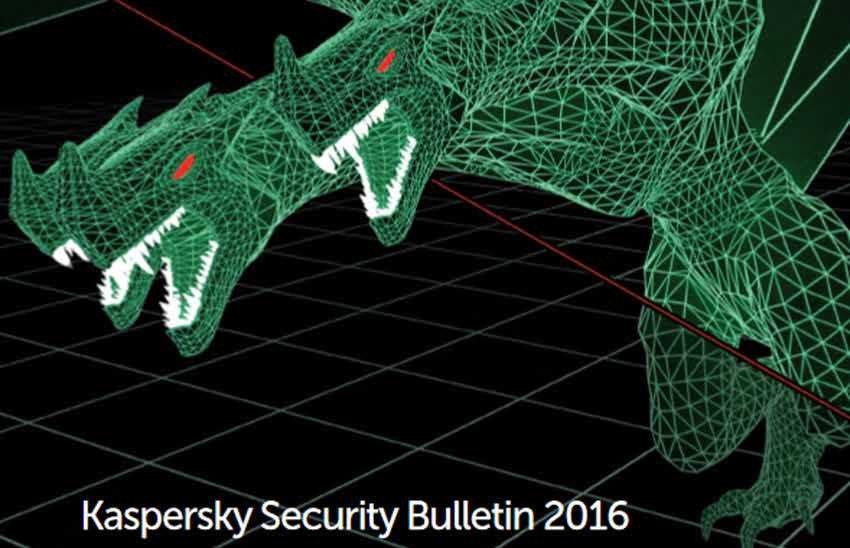Kaspersky: 2016, the biggest digital threats worldwide, concerned finances, information, and the desire to disrupt and violate data. These included the illegal trade in tens of thousands of login elements from broken serverss, interception of ATM systems, ransomware programs, malware software for mobile banking, as well as online espionage attacks as well as violation and leakage of sensitive personal data. 
These negative trends, their effects and the data they contain are covered by the annual one Report Kaspersky Security Bulletin Review And the Statistical References her.
2016's Kaspersky Lab research also reveals the extent to which businesses are struggling to locate a security incident quickly and effectively: 28,7% of businesses reported that it took them several days to spot such an event, while 19% admitted it took weeks, if not more time. For a small but significant minority of 7,1%, tracking lasted months. Among those who "fought" more often, the problem is often detected by internal or external security checks, or by third party alerts, such as by a customer or a consumer. More information on how late the detection of threats affects the recovery costs of the business, you can find in SUMMARY OF MAIN POINTS of the report.
Other things we learned about 2016:
- The shadow economy is bigger and more sophisticated than ever: just look at it xDedic - the shadow market for over 70.000 connection data from infringing servers that allowed anyone to buy access to a broken server, such as someone on a government network in an EU country for just $ 6
- The largest financial robbery did not include stock trading, as expected: instead, SWIFT transactions were used to steal 100 million dollars.
- Critical infrastructure is alarmingly vulnerable to many points, as revealed in late 2015 and early XNUMX 2016 through the digital assault BlackEnergy in Ukraine's energy sector, which included shutting down the electricity grid, deletion data and launching a DDoS attack. In 2016, Kaspersky Lab experts investigated the possibilities of industrial control threats and discovered thousands of providers worldwide exposed to the Internet, with 91,1% have vulnerabilities which one can manage remotely.
- A targeted attack may not follow any pattern: as it was shown by ProjectSauron APT, an advanced, modular digital espionage team that adapted its tools according to each goal, reducing their value as Indices of Compromise (IOCs) for any other victim.
- The electronic release of huge volumes of data can directly affect what people think and believe: as evidenced by ShadowBrokers and personal and political data leaks.
- Μια κάμερα ή ένα DVD player θα μπορούσε να αποτελέσει μέρος ενός παγκόσμιου ψηφιακού στρατού του Internet-of-things: καθώς η χρονιά τελειώνει, είναι σαφές ότι οι επιθέσεις που σχετίζονταν με το Mirai botnet is just the beginning.
“The number and scope of digital attacks and their victims that we encountered in 2016 put the issue of better detection at the top of the business agenda. Detection is now a complex process that requires security expertise, deep knowledge of the threat landscape, but also the development of skills to apply that expertise to any organization. Our analysis of digital threats over the years has revealed both specific patterns and unique approaches. This accumulated understanding actively underpins our defense tools, as we believe that protection technologies should be powered by security expertise. It also lies at the heart of our growing number of partnerships and cowork. We use the past to prepare for the future so we can continue to protect our customers from previously unknown threats before they can do any damage.” said David Emm, Principal Security Researcher Kaspersky Lab.
In a special video at Youtube you can see the information security protection overview.
The remarkable statistics for the year 2016 include:
- 36% of online banking attacks are now targeting Android devices, compared to just 8% 2015
- 262 million URLs were identified as malicious by Kaspersky Lab products, and there were 758 million malicious cyber-attacks worldwide - with one in three (29%) coming from the US and 17% from the Netherlands
- There were eight new "families" of malware for Point-of-Sale and ATM - an increase of 20% compared to 2015
- Attackers have used the Google Play Store to distribute malware for Android devices, with "infected" applications having "gone down" hundreds of thousands of times





